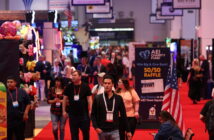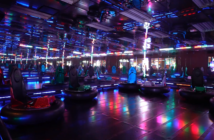Painting the Room With Light
The Latest Developments in Immersive Enclosure Development

by Kevin Williams, International Immersive Technology Special Correspondent
This feature was inspired by a well-received presentation I made during the VR Arcade Game Summit during this spring’s Amusement Expo, entitled “Get in The Box: Gaming Room Revolution!” The purpose was to provide a history and overview for a panel discussion of the application of immersive enclosure systems, designed to offer the next element of extended reality (XR) deployment into our industry’s out-of-home entertainment spaces.
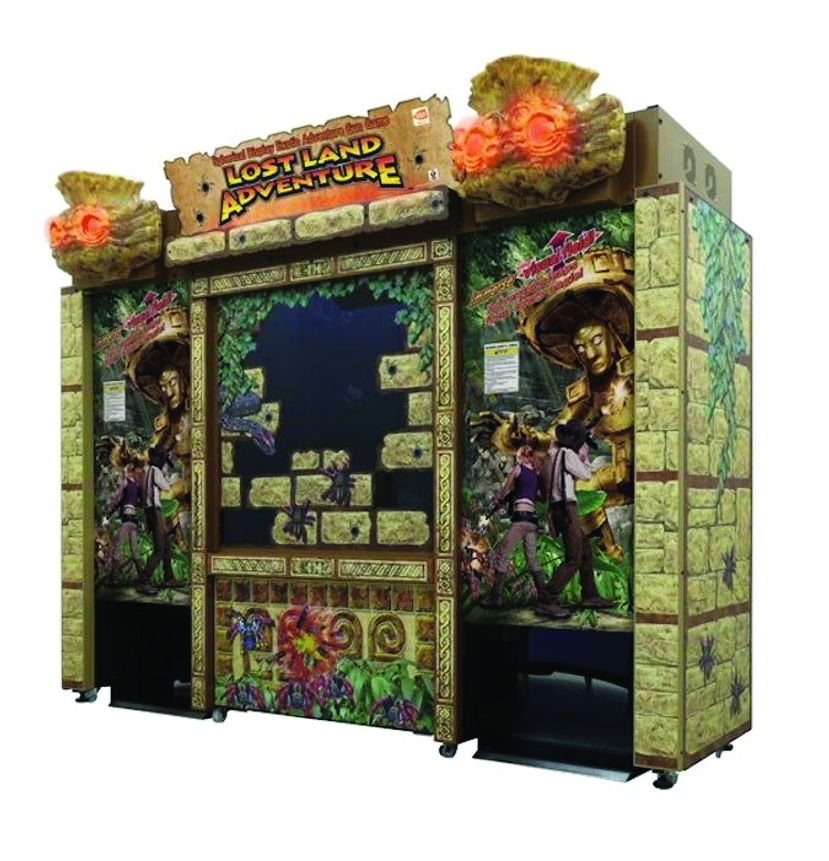
Bandai Namco’s Lost Land Adventure.
To understand how XR is hoping to supersede the more common deployment of VR, we need to trace the roots of this technology. The amusement scene, always an innovator of new forms of immersive and interactive entertainment, first saw an XR-style immersive projection system in 1993 with the iconic Galaxian 3 – Theater 6 attraction from Namco. The three-projector, laserdisc and CGi experience was one of the largest amusement pieces fielded to date and offered a literal theatre attraction for six players.
A reinterpretation of the projection enclosure experience would be attempted a few years later with the 2015 Lost Land Adventure, a two-player dome enclosure shooter. Bandai Namco would apply this enclosure dome projection experience to cockpit simulators such as Mobile Suit Gundam, Star Wars: Battle Pod and Mach Storm. This projection system offered the ability to place the player in the immersive environment without the need to wear cumbersome headsets.
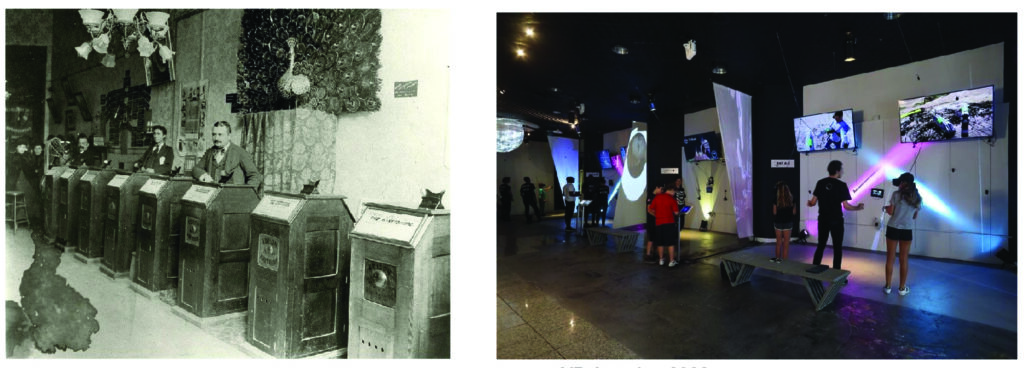
The idea of immersive entertainment isn’t new, it’s just the technology that has evolved as evidenced by this image shared by Williams during his presentation contrasting 1892 with VR of 2022. At left, a Kinetoscope Parlor (Holland Brothers, New York) and at right, a VR arcade (VR World, New York).
This aspect of immersive projection has been augmented using “projection mapping.” This entails having the projected image molded to map unique surfaces and complex curvatures of screens, and able to paint the interior of an enclosure with a digital image. This, of course, adds to the depth of immersion. Curved immersive display experiences incorporating multiplayer games can also be seen with platforms such as Triotech’s XD Theaters, allowing multiple players to compete in the same shooting experience.
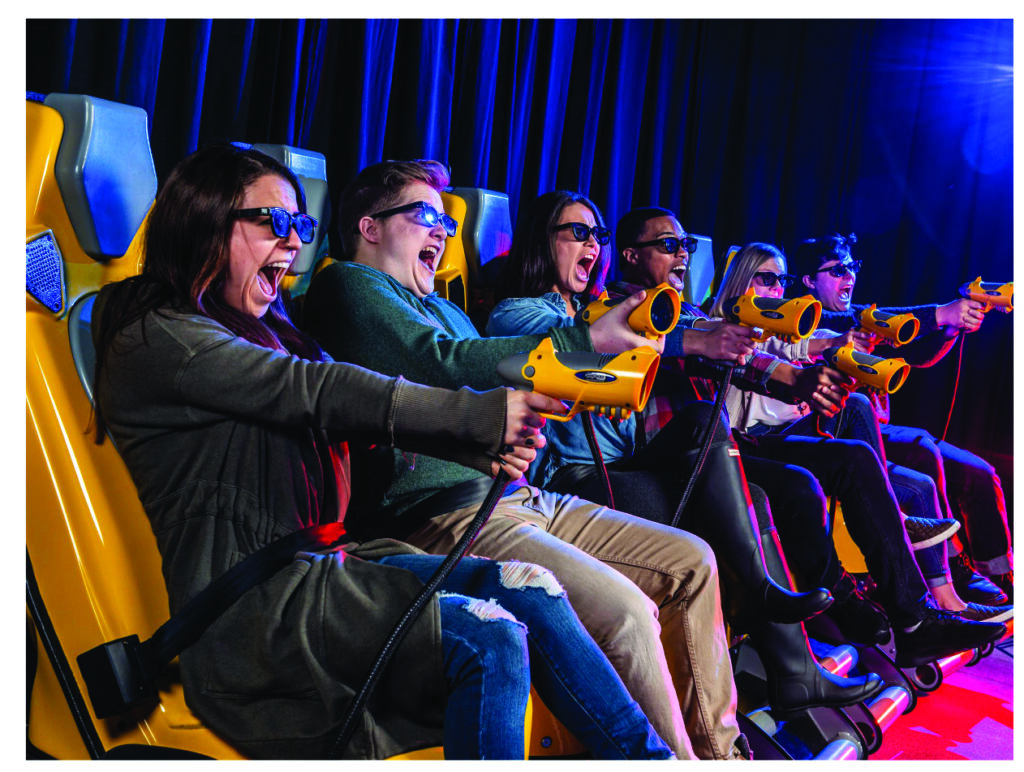
Current examples of gamified immersive experiences include Triotech’s XD Theater (above) and Activate’s The Grid (below).

The ability to offer these attractions as a turnkey platform deployed in a facility has resulted in unique laser mazes and interactive floor experiences such as the interactive floor systems from Pixel Games, now with over a dozen platform installations worldwide.
While standalone immersive enclosure systems have been fielded by the VR sector with the likes of the Omni-1 from Virtuix and Hyper Deck from MajorMega (now owned by Bay Tek), the encumbrance of VR headsets and the isolationism of VR experiences have encouraged developers to return to an immersive projection environment.
Once again, the Japanese amusement scene has been quick to embrace this. Taito was the first by releasing their Space Invaders 40th anniversary floor projection game experience. They took this one step further by creating a unique four-player fully projection attraction called the Space Cube. (The players compete within the enclosure, shooting the walls as hordes of space invaders attack.) The Cube system would go on to be supported with other game content, expanding the concept.
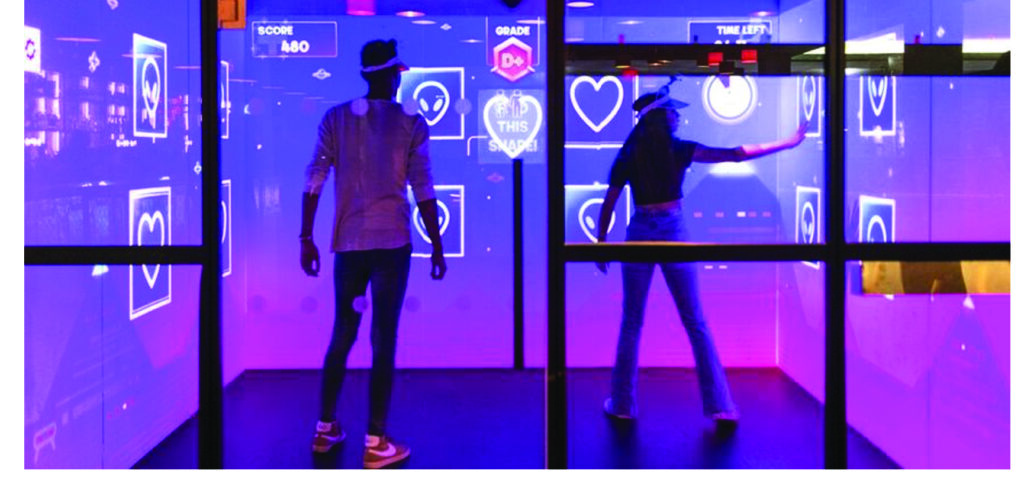
Immersive Gamebox (above) uses a unique hat-based tracking system. Valo Motion’s ValoArena (below) offers a library of social mixed-reality multiplayer games for all ages.
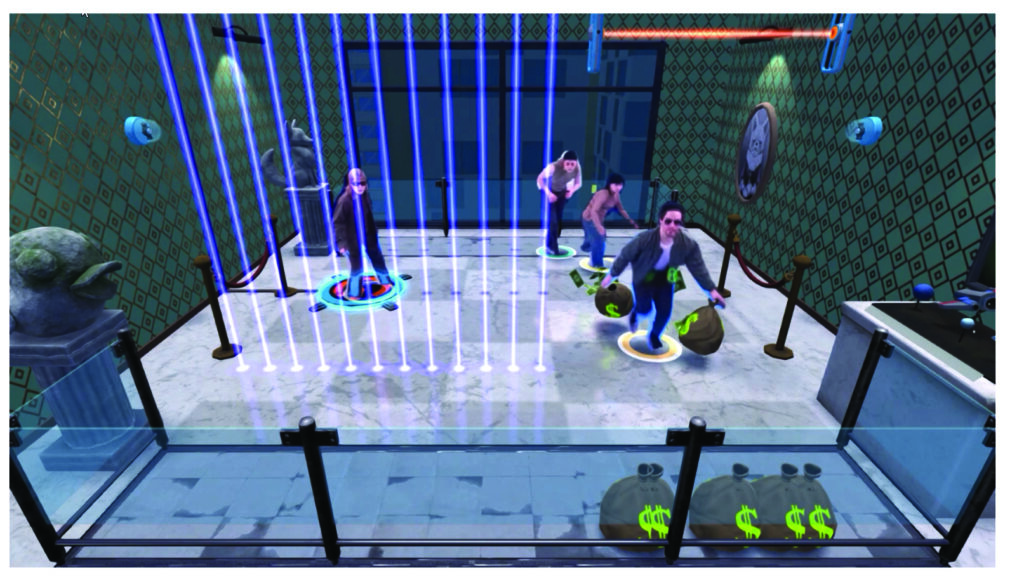
The rest of the Western entertainment scene has been quick to jump on the opportunity of multi-player immersive entertainment enclosures. Developer and operator Immersive Gamebox released their four-player enclosure system internationally, using a unique hat-based tracking system to position the players’ movements with their avatar projected on the walls of the so called “game box.” The company is developing their own games, as well as licensing IP such as with their Squid Game title in collaboration with Netflix. The high levels of physicality – of having the players movements represented in the game – offers a level of engagement unachievable from more conventional video games.
The creation of a compelling multi-player experience is also represented by Valo Motion with their ValoArena. Players’ movements are captured by computer vision and their likeness and movements are represented onscreen in the game while they are playing. Highly physical and fun, these games pit the groups of players together. The company has launched their latest title, Photobomb, which is the sixth for their platform, which again offers a six-player, fast-paced game aimed at getting the entire family to “get into the picture!” This platform is now being sold through Creative Works under a new collaboration.
Immersive enclosure platforms are now ubiquitous as a new genre for interactive entertainment. Developer Attraktion! has released their PlayNeo enclosure game system in three configurations: box (for four to six players), “trapeze” for seven to nine players or 360° for 10-16 players. The free-roam, projection environment allows the players to use their “Shieldsz” controllers to blast the screens. Attraktion!’s latest title for the platform is licensed and based on Angry Birds.

Inowize’s QBIX offers immersive play for six players in an unattended environment with wind and floor effects as well as visuals.
Amusement and attraction developer Inowize created their own unique interpretation of the immersive enclosure concept with their launch of the QBIX platform. This unattended system allows six players to compete in several game experiences utilizing the system’s projection environment which also has 5D effects. Wind and floor motion add to the immersive visuals. The company offers four games for the system and is reportedly working on several other properties.
Another new entrant into this scene is the Arcade Arena, which bills itself as “social casual gaming.” Video games come to life through use of projection mapping technology, motion tracking cameras and LiDARs. Custom games have players phyically interacting with giant touchscreens and traditional game controls.

Game Volt’s The ARENA is a 4-player game enclosure that has been deployed at some Dave & Buster’s locations.
A new system entering the scene from Game Volt, includes LED display technology into the mix of immersive enclosures, along with the physicality of actual ball-throwing systems. The ARENA is a four-player, skill-based game enclosure that comprises all the elements for a frantic game experience. The system is currently being deployed by Dave & Buster’s as part of their social entertainment initiative to offering a social game environment they believe will be compelling to their target audience.
It is this social entertainment element that is driving the latest phase of immersive enclosure development, rather than standalone attractions. These systems are being deployed in unique competitive socializing venues which are springing up internationally. We see chains deploying projection-screen games with physical ball-launching elements, such as Sixes with its cricket theme, or TOCA Social with soccer. Baseball and golf are also being given the immersive enclosure treatment in locations such as the Five Irons Golf chain of simulator centers.
Ball-launched, tracked gameplay, married to immersive projection, has been launched in packages from other manufacturers such as PlayMind with their multiplayer systems and NeoXperience with their ball-throwing game environments. Balls hitting the projected screen are tracked and can interact with the game experience.
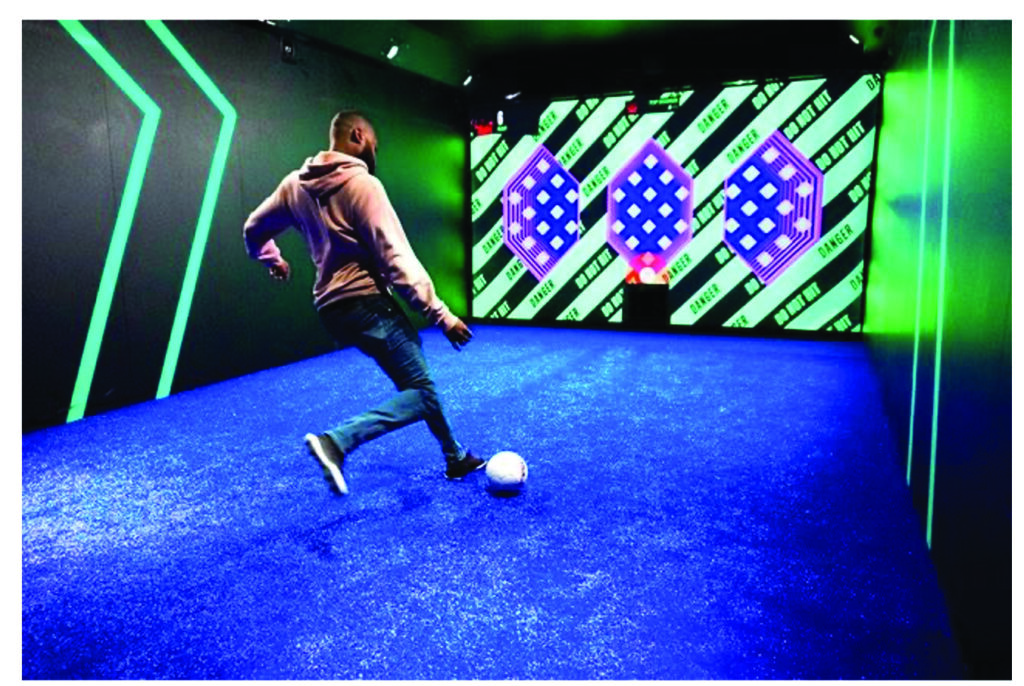
Sports simulators range from soccer (as seen in the above photo from TOCA Social) and golf to cricket, baseball and even skeet shooting. Below is an example of how karting is taking advantage of projection systems to create virtual race courses.
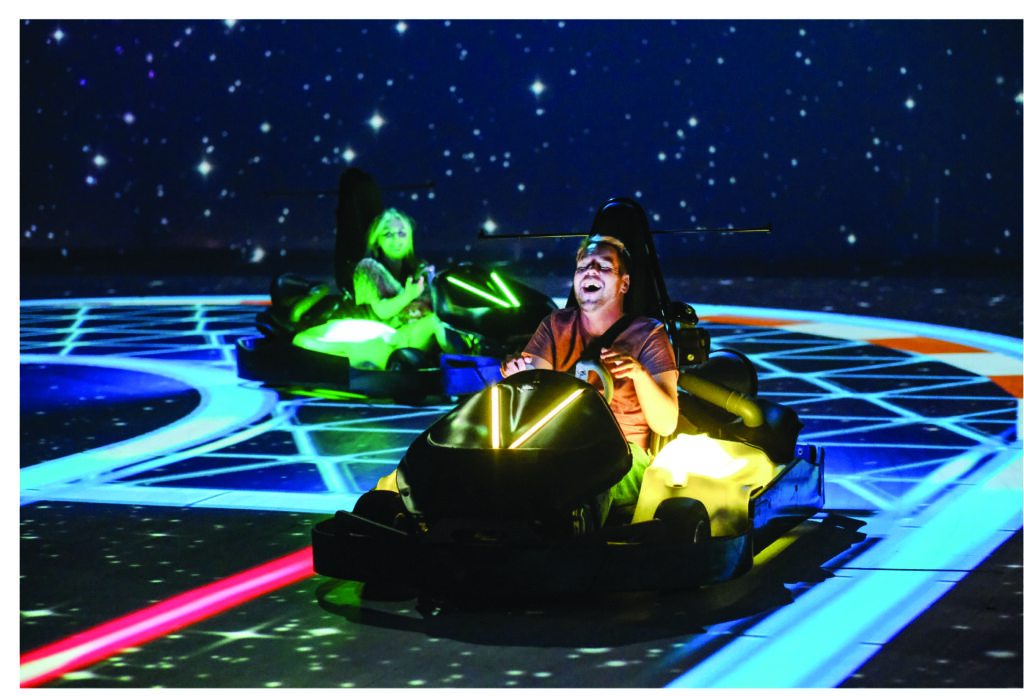
The ability to track objects within a projected environment also leads to the latest innovation in this scene. Immersive projection has been deployed in go-karting. Developers Battle Kart and Chaos Karts are examples of indoor karting experiences that utilize multiple unique projection systems to create virtual racecourses to compete on. The result is the creation of a real-life version of Mario Kart with players able to avoid hazards and launch weapons at opponents.
The future looks bright for immersive enclosure systems, unencumbered by the limitations of headsets and connected displays. The advancements in new laser light projectors and innovations in new display mediums mean that the ability to place groups of players within a fully interactive entertainment environments will prove a compelling draw for future audiences. Expect to see immersive display technology applied to many other aspects of the amusement arena.
Kevin Williams, a respected specialist on entertainment and technology and assisting international clients in developing immersive and interactive entertainment technology and facilities. Kevin is founder of KWP, which provides expertise in immersive out-of-home entertainment for retail destinations and beyond.
He is founder and publisher of The Stinger Report “e-”zine for those working or investing in the amusement, attractions and entertainment industry.
Kevin is a prolific writer and provides regular news columns for main trade publications. He also travels the globe as a keynote speaker, moderator and panelist at numerous industry conferences and events.
The second edition of his book, The Out-of-Home Immersive Entertainment Frontier: Expanding Interactive Boundaries in Leisure Facilities, is scheduled for release soon. Kevin can be reached at kwp@thestingerreport.com


